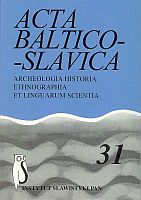Język i obyczajowość szlachty litewskiej na podstawie korespondencji prywatnej z 2. połowy XIX wieku (na przykładzie jednej rodziny)
Language and customs of the Lithuanian nobility on the basis of private correspondence from the second half of the 19th century (the exam. of Sawicki)
Author(s): Anna Zielińska, Zofia Sawaniewska-MochowaSubject(s): Cultural history
Published by: Instytut Slawistyki Polskiej Akademii Nauk
Keywords: nobility from the Kowno/Kaunas province; the 19th century; private correspondence; mentality; the nobility sociolect
Summary/Abstract: In the article we analyze two constitutive elements of the nobility culture: mentality (social norms, moral values, customs) and language. Private correspondence of Sawicki family forms the basis for our linguistic-cultural research. Choice of that family is not accidental, because family members come from moderately rich Lithuanian nobility from Kiejdany/Këdainiai. It is representative for ways of thinking and communication that was characteristic of the nineteenth century nobility from the Kowno (Kaunas) province of the Russian Empire. First part of the article takes on the material character, contains extensive fragments of letters that provide documentations for family members occupations, their economic and health problems, questions of education and self-teaching and basic aspects of mentality: obeying rules of politeness, respect for parents and the elders, admiration for children, religiousness, mistrust towards strangers. In second part of the article there is a review of representative linguistic features that have got, in our opinion, sociolectal character. Among these phenomena we put processes from the borderline between spelling and pronunciation (especially instability of diacritics, misidentification of consonants in three sequences z || ź || ž), phonetics and inflection (neutralisation of feminine endings in the singular verb forms of 1st and 2nd person in simple past tense -am > -em, -aś > eś) and lexical facts ( presence of borrowings from Latin and French, regional and dialectal forms, numerous prefixed verbs, archaisms, individualisms, not numerous Russian lexical influences connected with administration and military affairs).
Journal: Acta Baltico Slavica
- Issue Year: 2007
- Issue No: 31
- Page Range: 235-265
- Page Count: 32
- Language: Polish

